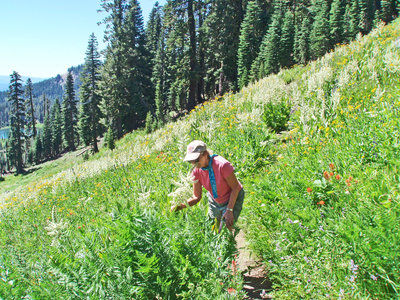
Have you thought about creating a meadow but don’t know where to start? Need some inspiration to get going? Take a hike through the breathtaking meadows in Lassen Volcanic National Park like I did recently, and you’ll get all the ideas you need to create the meadow of your dreams in your own backyard.
Nature is not subtle when painting a scene, and neither should you be. In Lassen, I hiked through waist-high meadows of blue lupine and pale lilac coyote mint. White corn lily spikes grew tall and majestic, providing contrast, and drifts of goldenrod and Indian paintbrush added just the right amount of punch.
The meadows took my breath away. I marveled at swaths of mariposa lily, pussy paws, alpine aster, scarlet gilia.
So many wildflowers — so little time. You can have the same thing each spring and summer. Here’s how.
Meadows can supply an ever-changing display of seasonal colors and textures. A natural meadow has grasses of varying heights, bloom times and colors. Self-sowing wildflowers mix in between perennials and grasses in drifts. Sure, there are lots of different flowers in a meadow, but mixed throughout are drifts and large patches — and it’s the combinations of both that makes a meadow look natural.
Around the borders of your meadow, make sure to plant insect-magnets such as rudbeckia, agastache, monarda and Russian sage, or other perennials.
Establishing a meadow requires a bit of patience, but once you’ve gotten rid of existing weeds, your drifts of wildflowers, perennials and small shrubs will take care of themselves with just a little follow-up weeding. Weed control is essential and should be accomplished prior to planting. Now is a good time to start by working in compost, watering the area to bring up the weed seeds, and then hoeing them off in about three weeks.
If you plan to include grasses in your meadow, get them established before starting wildflowers from seed, or the wildflowers will overwhelm the young grasses. You can mimic nature by using native shrubs to form the bones of your meadow. Try coffeeberry and toyon, and then fill in around them with flowering natives such as monkey flower and monardella.
A meadow of California natives might feature a colorful carpet of seaside daisy, golden aster, blue-eyed grass and checkerbloom, or simply a blend of dune sedge and yarrow. Just remember to plant in drifts to get the most impact.
Another good combination for a hot, sunny meadow would be buckwheat, silver lupine, salvia and foothill penstemon. Or try combining rockrose, agastache, russian sage and gaura interspersed with some drifts of wildflowers. What about penstemon, gaura and Mexican primrose mixed in with lion’s tail?
Shade gardeners might enjoy a meadow of bush anemone, Pacific Coast iris, columbine and wild ginger. Or try combining salal, dicentra eximia, hellebore and campanula in the shade.
Some gardens have nearly year-round natural moisture. Good choices for this type of meadow are miscanthus grasses, daylily, asters, monarda and cornflowers from seed. Wild columbine, hardy geraniums, gloriosa daisy and asclepsia also work in a moist meadow, as would chondropetalum, yellow flag, calla lily and lobelia cardinalis.
Most meadows can be cared for with an annual pruning in early winter. Wait until some of the wildflower seeds have ripened before cutting to ensure a new crop of wildflowers and grasses next year. Weed between plants until they have had a chance to become established and fill in. The shrubs and other perennials might need a little cleanup in the spring, too.
If you would like to see some of the other wildflowers I enjoyed, check out the Lassen National Park website at www.nps.gov/lavo/naturescience/Lassen-Wildflowers.htm
Jan Nelson, a landscape designer and California certified nursery professional at Plant Works in Ben Lomond, will answer questions about gardening in the Santa Cruz Mountains. Contact her at Ja******@*ol.com or her Web site www.JanNelsonLandscapeDesign.com where readers can view previous articles and pictures on her blog.











